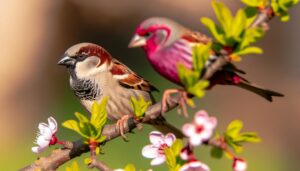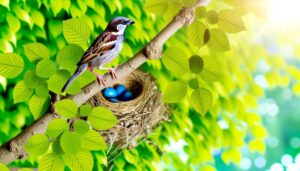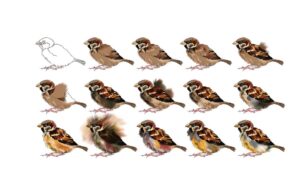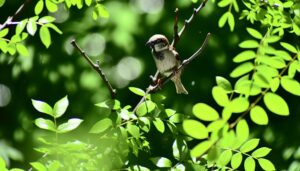Get a Sparrow Out of Your House in 7 Steps
Effectively guiding a sparrow out of your house requires calm and methodical actions. Begin by observing the bird's behavior and location, and close off other rooms to contain it.
Open doors and windows to create a clear exit path and turn off interior lights to utilize natural light for guidance. Maintain a serene environment by reducing noise and moving slowly.
Should the bird remain, employ a soft towel for safe capture by approaching it gently. To prevent future entries, inspect and secure potential entry points such as vents and windows.
For a detailed step-by-step approach, continue exploring the topic.
Key Takeaways
- Close off other rooms to create a controlled environment and guide the sparrow towards open doors or windows.
- Turn off interior lights and use natural light to guide the sparrow outside.
- Move slowly and calmly to avoid startling the bird and reduce stress.
- Cover the bird gently with a soft towel for safe capture if needed.
- Inspect and secure potential entry points to prevent future bird entries.
Stay Calm and Assess
Begin by taking a deep breath to maintain composure and carefully observe the sparrow's location and behavior within the house. Assess the immediate environment to identify any potential hazards or escape routes for the bird.
Note whether the sparrow is perched calmly or flying erratically, as this will determine the importance and method of intervention. Document any accessible windows or doors that could facilitate a safe exit for the bird.
Additionally, observe if the sparrow appears injured or stressed, which may require a gentler approach. Understanding these factors is vital for formulating an effective plan to guide the sparrow out without causing harm to either the bird or the household environment.
This initial assessment is foundational for a successful resolution.
Close Off Other Rooms
To prevent the sparrow from venturing further into the house, meticulously close off all other rooms by shutting doors and sealing any potential entryways. This step is crucial in confining the bird to a manageable area, thereby simplifying the removal process.
Begin by inspecting each room for open doors, windows, and vents, ensuring they are securely closed. Utilize towels or draft stoppers to block gaps under doors, which could serve as escape routes.
Additionally, instruct family members to remain in their designated rooms to avoid inadvertently frightening the bird into new areas. By creating a controlled environment, you will greatly reduce the complexity of guiding the sparrow out, ultimately facilitating a smoother and more efficient resolution.
Open Doors and Windows
To facilitate the sparrow's exit, it is essential to open doors and windows, thereby creating clear pathways for escape.
Utilizing natural light can guide the bird towards these exits, as sparrows instinctively move towards light sources.
Additionally, minimizing indoor movement will reduce stress for the bird, encouraging it to find its way outside more calmly and efficiently.
Clear Exit Pathways
Opening doors and windows in a strategic manner is vital for providing the sparrow with clear exit pathways, making sure that it can easily navigate its way out of the house. Begin by identifying the most accessible exit points, ideally those that lead directly outdoors. It is important to create an unobstructed route for the bird to follow.
Take the following steps to guarantee success:
- Open all windows and doors in the room: This maximizes the chances of the sparrow finding an exit.
- Close interior doors: Prevent the bird from venturing further inside the house.
- Remove obstacles: Clear the area of furniture and clutter that may confuse or hinder the sparrow.
- Remain calm and quiet: Minimize movement to avoid startling the bird and encouraging erratic flight patterns.
Use Natural Light
By leveraging natural light, you can effectively guide the sparrow towards open doors and windows, creating a well-lit pathway that encourages the bird to move towards the exit. Start by turning off all interior lights, which can confuse the bird.
Next, open all available doors and windows to maximize natural light and create an obvious escape route. Make sure that any curtains or blinds are fully drawn back to allow the maximum amount of sunlight to enter the room.
The contrast between the darkened interior and the bright exit points will naturally attract the sparrow towards the open spaces. Patience is key; allow the bird time to recognize and follow the illuminated path to freedom.
Minimize Indoor Movement
To lower the chances of startling the sparrow and causing erratic flight patterns, make certain that all household members remain still and minimize their movement within the home. This will help create a calm environment, encouraging the sparrow to focus on finding an exit. Open all accessible doors and windows to provide clear escape routes.
Keep pets secured: Ensure that pets are confined to another room to prevent them from chasing or frightening the bird.
Limit human activity: Encourage family members to stay in one room until the sparrow has left.
Avoid loud noises: Turn off televisions, radios, and other sources of disruptive sounds.
Use gentle guidance: If necessary, softly guide the sparrow with a broom towards an open door or window.
Turn Off Lights Inside
Dimming or turning off interior lights can effectively guide the sparrow towards naturally illuminated exits, leveraging its instinctual attraction to daylight.
Begin by identifying all possible exits, such as open windows and doors, ensuring they are fully accessible.
Switch off all artificial lights within the house to create a stark contrast between the darker indoor environment and the brighter outdoor spaces. This contrast helps the sparrow locate and navigate towards the exit more efficiently.
It is essential to eliminate any competing sources of light that might confuse the bird.
Use Gentle Guidance
Employing calm and deliberate movements can greatly aid in gently guiding the sparrow towards an open exit, ensuring minimal distress for the bird. By maintaining a composed demeanor, one can effectively manage the situation.
Here are some methodical steps to follow:
- Approach Slowly: Move towards the sparrow with slow, controlled motions to prevent sudden fright.
- Use Soft Vocal Cues: Speak in a gentle, soothing tone to reassure the bird and reduce its anxiety.
- Extend Your Arm: Gradually extend your arm or use an object like a broom to steer it gently.
- Avoid Sudden Movements: Quick gestures can startle the sparrow, causing it to panic and potentially injure itself.
Following these steps will promote a calm and successful resolution.
Create a Clear Exit Path
To facilitate the sparrow's departure from your home, it is essential to create an unobstructed exit path. Begin by opening all windows and doors to provide a clear route for the bird.
Additionally, quickly remove any physical obstacles and minimize noise sources to reduce the sparrow's stress and encourage its natural flight towards freedom.
Open All Windows
Opening all windows in the room will create a clear and unobstructed exit path for the sparrow to escape. This step is essential to guaranteeing the bird can find its way out without confusion or injury.
Here's a systematic approach to opening windows effectively:
- Identify All Windows: Locate every window in the room, including any that may be concealed behind curtains or blinds.
- Unbolt and Open: Carefully unbolt and fully open each window. Make sure that screens are removed to allow the sparrow to fly out.
- Secure Curtains: Tie back or remove curtains to prevent them from blocking the exit path.
- Minimize Noise: Perform these actions quietly to avoid startling the sparrow, which could cause it to fly in the wrong direction.
Remove Obstacles Quickly
Clearing the room of any obstacles is essential to guaranteeing the sparrow has a direct and unobstructed route to the open windows. Begin by removing any large furniture, decorative items, and clutter that may impede the bird's flight path. This includes tables, chairs, and any hanging decor that could confuse or trap the sparrow.
Next, make sure that doors leading to other rooms are closed to prevent the bird from wandering further into the house. Additionally, pull back any curtains or blinds to maximize the visibility of the exit points.
Minimize Noise Sources
After ensuring a clear and unobstructed path for the sparrow, it is imperative to minimize noise sources to reduce stress and encourage the bird to calmly exit the house.
Noise can heighten the sparrow's anxiety, making it more difficult for it to find the exit. Consider the following steps to create a serene environment:
- Turn off any loud appliances: This includes televisions, radios, and vacuum cleaners.
- Silence mobile phones and alarms: Even small beeps can startle the bird.
- Ask everyone to remain quiet: Conversation and movement can be very disturbing.
- Close windows to external noise: Traffic sounds or neighborhood activity can also cause stress.
Avoid Sudden Movements
Minimizing sudden movements is vital to prevent further agitating the sparrow and to guide it safely out of the house. Abrupt actions can startle the bird, causing it to fly erratically and potentially injure itself.
To create a calm environment, move slowly and purposefully. Make sure that all individuals in the vicinity are aware of the need to remain still and avoid quick gestures. This methodical approach helps the sparrow to feel less threatened, increasing the likelihood that it will find its way to an open exit.
Additionally, maintaining a quiet demeanor complements the slow movements, further reducing stress on the bird. Consistency in these actions is essential for a successful and humane resolution.
Use a Towel if Needed
In situations where the sparrow remains stubbornly indoors despite other efforts, employing a towel as a gentle capture tool can be an effective strategy. This method requires patience and careful execution to guarantee the bird's safety.
Follow these steps meticulously:
- Prepare the Area: Close off other rooms to limit the sparrow's movement and create a confined space.
- Select an Appropriate Towel: Choose a lightweight, soft towel to avoid harming the bird.
- Approach Slowly: Move steadily towards the sparrow, ensuring minimal stress.
- Gently Cover and Capture: Drape the towel over the bird softly, then carefully gather it without applying pressure.
Prevent Future Entries
To prevent future entries of sparrows into your home, it is vital to conduct a thorough inspection of potential entry points and secure them effectively.
Begin by examining windows, vents, chimneys, and any small openings around your home's exterior. Make sure that window screens are intact and repair any tears promptly. Install bird-proof mesh over vents and chimneys to eliminate access. Additionally, check for gaps around doors and windows and seal them with weatherstripping or caulk. Regularly maintain and inspect these barriers to ensure ongoing effectiveness.
Trim trees and shrubs near the house that could provide easy access for birds. By implementing these measures, you can noticeably reduce the likelihood of sparrows entering your home in the future.
Conclusion
To sum up, successfully removing a sparrow from a household environment necessitates a systematic approach characterized by calmness and strategic planning. Critical steps include isolating the bird, providing clear exit routes, minimizing indoor lighting, and employing gentle guidance.
The theory that chaotic or hurried actions exacerbate the bird's stress is substantiated, underscoring the importance of avoiding abrupt movements. Implementing preventive measures can mitigate future occurrences, thereby maintaining a harmonious coexistence between human living spaces and avian visitors.






